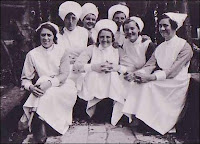Past Trends in Nursing
In 1935, when Social Security was introduced, the emphasis in nursing was on caring for the ill elderly. This was logical because nurses came from hospital schools of nursing and were trained to meet the needs of hospitals.
 The concept of caring for the elderly in boarding houses or convalescent homes can be traced back to early American history. Licensed facilitaties began to appear in the 1930s and 1940s. Due to attitudes about aging, nursing homes were looked upon, in general, as substandard institutions in which to practice nursing. Nonprofessional care-givers were often poorly prepared for the task of caring for ill and dependnt residents. Standards of care left much to be desired.
The concept of caring for the elderly in boarding houses or convalescent homes can be traced back to early American history. Licensed facilitaties began to appear in the 1930s and 1940s. Due to attitudes about aging, nursing homes were looked upon, in general, as substandard institutions in which to practice nursing. Nonprofessional care-givers were often poorly prepared for the task of caring for ill and dependnt residents. Standards of care left much to be desired.By 1950, references to geriatrics were included in some basic nursing textbooks, but geriatric nursing was not given much attention. Aging was not generally presented as a normal process with potential problems and implications for preventive nursing. In one hospital school of nursing, a suggested approach to the care of the ill elderly was to “treat them as if they are your own grandparents”. Elderly people were being treated and cared for, no matter how kindly, as having outlived their usefulness. Few nurses had an interest in a field where hopelessness was the prevailing attitude and challenge was absent.
Nursing literature of the 1960s discussed the increasing population of older persons. Aging was equated with an increased incidence of degennent in health care planning was lacking. Textbooks discussed the growing number of older people as a strain on health care resources. Projections for the future suggested the need for more home health care agencies and long-term care facilities.
Reference :
Farrell J : Nursing Care of the Older Person, J.B. Lippincott Company, Philadelphia, 1990.

